By
Jeff Rumburg
|
Date Published: June 18, 2019 - Last Updated September 08, 2020
|
Comments
Spotlight on Culture and Metrics: Join Jeff at ICMI Contact Center Connections from October 28-30 in Chicago. He'll be speaking on a number of topics related to culture and metrics.
There is no universal definition of employee engagement, yet everyone
seems to know what it means. How can this be? Although the term has not
been rigorously defined, there seems to be universal agreement that
employee engagement and employee job satisfaction are highly
correlated. In fact, many who write on the topic of employee engagement
simply conflate the two terms, and treat employee engagement and
employee job satisfaction as one and the same thing. But they are not
the same thing. Employee engagement is a complex set of behaviors
driven by numerous contact center practices that can be hard to
quantify. These include employee recognition, wellness, personal
growth, team huddles, and relationships with peers. Employee job
satisfaction, by contrast, is a metric that by definition, is
quantifiable.
Assuming that conventional wisdom is correct, and that agent job
satisfaction is a strong proxy for employee engagement, I will focus in
this article on the metric of agent job satisfaction and the underlying
drivers of job satisfaction.
Agent Job Satisfaction Defined
Agent Job Satisfaction is the percentage of agents in the contact center
that are either satisfied or very satisfied with their job. It is typically
measured annually or semi-annually using an agent satisfaction survey (
sample here
). Unfortunately, fewer than 30% of all contact centers track agent job
satisfaction. When I ask clients why they don’t track this metric, the
answer is usually the same: it’s too difficult to measure, or the metric
just isn’t that important. On both counts, they are wrong. Here’s why.
Why It’s Important
Agent Job Satisfaction is a bellwether metric that impacts many other
metrics in the contact center. It is positively correlated with customer
satisfaction and negatively associated with absenteeism and turnover,
meaning that absenteeism and turnover go down as agent job satisfaction
goes up. It turns out that the adage “happy agent equals happy
customer” is not just a cliché; it can be demonstrated empirically! Figures
1, 2, and 3 below show these correlations using data from MetricNet’s
contact center benchmarking database.
Figure 1: Agent Job Satisfaction vs. Customer Satisfaction
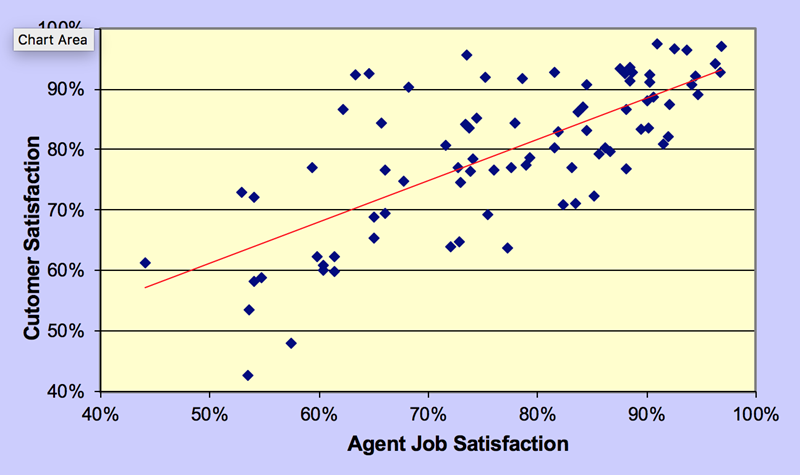
Figure 2: Agent Job Satisfaction vs. Annual Agent Turnover
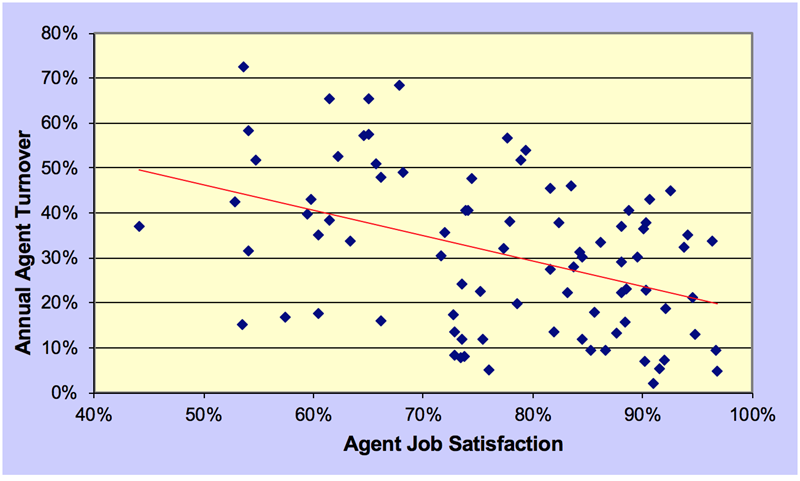
Figure 3: Agent Job Satisfaction vs. Daily Agent Absenteeism
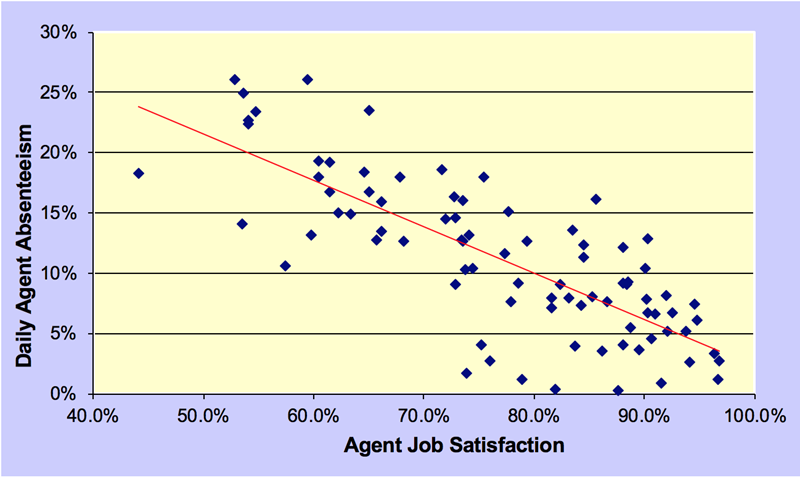
So, why do we care about these correlations? First, they are not just
spurious correlations; they are cause-and-effect relationships. Agent job
satisfaction (along with first contact resolution rate) drives
customer satisfaction; it drives agent turnover, and it drives agent absenteeism. More importantly, if we can control
agent job satisfaction (which we can), we can drive real improvements
in customer satisfaction, turnover, and absenteeism.
The second reason is that high agent job satisfaction has positive economic
benefits. It’s no secret that the contact center industry experiences
extremely high turnover. The average agent turnover in contact centers
worldwide last year was greater than 40%! Since improvements in agent
job satisfaction can reduce agent turnover and absenteeism, it can also
reduce the costs associated with turnover and absenteeism. In North America, the direct cost of replacing a contact center agent, including the cost of
screening, recruiting, interviewing, and training an agent is more than
$12,000. And this does not even take into account the value of the
knowledge and expertise that is lost when an agent leaves the contact
center. Turnover is indeed costly!
According to research conducted by McKinsey & Company, engaged and
satisfied contact center employees are 8.5X more likely to stay than leave
within a year, 4X more likely to stay than dissatisfied colleagues, 16X
more likely to refer friends to their company, and 3.3X more likely to feel
extremely empowered to resolve customer issues.
Key Drivers of Agent Job Satisfaction
I mentioned above that agent job satisfaction can be controlled. But how?
Many contact centers struggle with low morale among their agents, and
appear unable, despite their best efforts, to maintain a high level of
agent morale in the contact center. Can we do something proactive
to manage and improve agent job satisfaction? The answer is yes, and the
solution is surprisingly straightforward.
It turns out that the most reliable drivers of agent job satisfaction are
training hours, coaching hours, and the existence of a formal career path.
Once again, we can turn to our benchmarking data to make this point.
Figures 4 and 5 below show how training and career pathing impact agent job
satisfaction.
Figure 4: Annual Training Hours vs. Agent Job Satisfaction
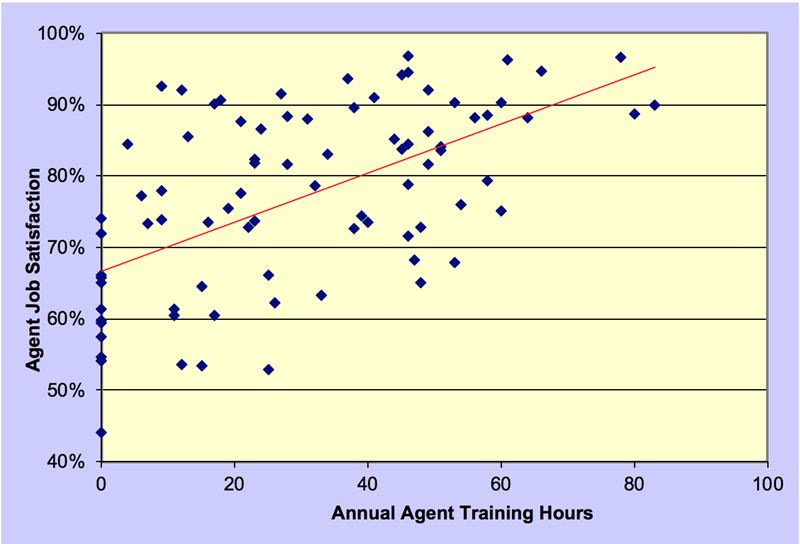
Figure 5: Career Pathing and Agent Job Satisfaction
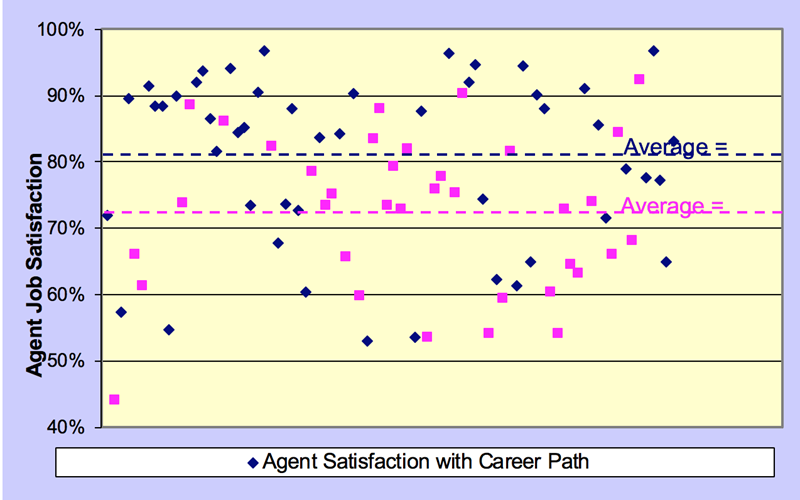
Other Factors Impacting Job Satisfaction
One factor, frequently overlooked, that has huge implications for agent job
satisfaction is the effectiveness of recruiting. Oftentimes a contact
center agent with low job satisfaction is simply a poor fit for the job.
They may have interviewed well, tested well, and passed their initial
training courses with flying colors. But if they are unable to withstand
the day-to-day rigors of a fast- paced contact center environment, they may
collapse under the pressure and become unhappy over time. Is there any way
to foresee and prevent this phenomenon? The answer is yes, and an increasing
number of contact centers are doing so by including psychometric testing in
their recruiting process.
Psychometric testing is a standard, scientific method used to measure a
candidate’s aptitude and behavioral style. It is designed to determine a
candidates' suitability for a particular role based on the required
personality characteristics and cognitive abilities of the job. Employers
use the results of psychometric testing to identify behavioral “matches” to
the position that are otherwise difficult to determine from face-to-face
interviews or other types of testing.
Clear and quantifiable agent performance standards also have a positive
impact on job satisfaction. In one recent project I managed for a health
care company, agent scorecards were implemented in an effort to drive
accountability, transparency, and visibility into individual agent
performance. The scorecard, shown below, contained just three metrics:
customer satisfaction (a quality metric), contacts handled per month (a
productivity metric), and first contact resolution rate (an effectiveness
metric). These three metrics drive the right behavior in agents and enable
supervisors to provide more effective feedback (sample below).
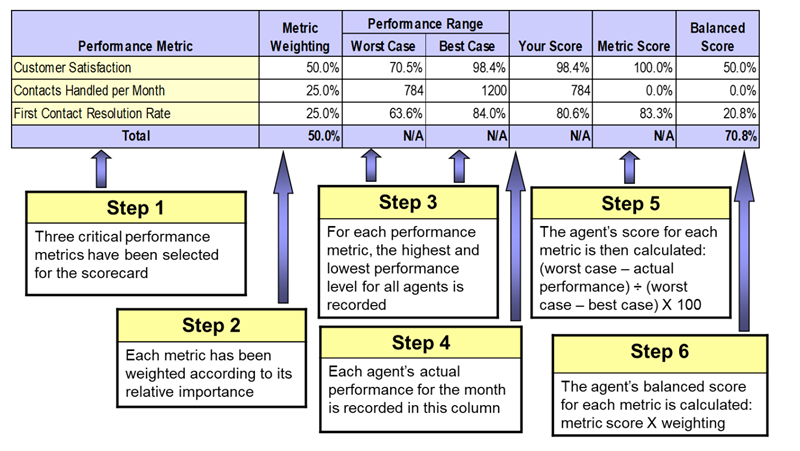
Depending upon the metrics you track in your contact center, you may choose
more metrics or a different mix of metrics for your agent scorecard. Once
you select the metrics for the agent scorecard, you establish a weighting
for each metric based upon its relative importance. Step 3 is to show a
reasonable range of performance – worst case to best case – for each
metric. Normally these performance ranges are adjusted monthly, based on
the worst and best agent performance in the contact center. In step 4, the
agent’s actual performance for each metric is inserted into the third
column from the right. A score for each metric is then calculated based on
the interpolation formula in step 5. And finally, a balanced score for each
metric is determined by multiplying the metric weighting by the metric
score. When the balanced scores for each metric are summed up, you have the
total balanced score for the agent!
In this example, the agent’s balanced score is 70.8%. Every agent’s
balanced score will always range from 0% (if they have the worst possible
performance for every metric in the scorecard) to 100% (if they have the
best possible performance for every metric in the scorecard). It turns out
that the agent in our example has scored well. When we run hundreds of
contact center agents through this algorithm, we get a normal distribution
centered right at 50%. Those who score above 60% are typically in the top
quartile; those who score between 50% and 60% are in the second quartile;
those between 40% and 50% are in the third quartile, and those below 40%
are generally in the bottom quartile for overall service desk performance.
Using the scorecard, supervisors can coach their agents each month and show
them, based on their monthly metric scores, where they need to focus their
time and attention. A low score on a particular metric shows an area that
needs improvement, while a high score on a particular metric highlights an
area of strength. In our sample scorecard above, the agent’s first contact
resolution was outstanding at 100%, while their tickets per month score was
quite low at 0%. The quick diagnosis for this agent’s performance is that
they are delivering outstanding quality, but they are doing so at the
expense of productivity and need to improve productivity by handling a
larger volume of tickets each month.
Let me also point out that a persistent myth in the industry – that agents
don’t want to be measured or held accountable for their performance – is a
fallacy. Nothing could be further from the truth. In fact, the best
performing contact center agents want transparency, visibility,
and accountability because they have nothing to fear, and these workplace
attributes give them the insight they need to improve their performance. In
most cases, contact centers that implement the agent balanced scorecard
will also post the agent ratings on a monthly basis, as shown below. The
intent here is to help each agent see how they are performing relative to
their peers, and provide an incentive for every agent to improve their
performance over time. Why does all this matter? Because it can be shown
empirically that contact centers that have implemented agent performance
targets, and particularly those who have agent scorecards, enjoy
significantly higher job satisfaction scores than those contact centers
that don’t have quantifiable agent performance targets or scorecards.
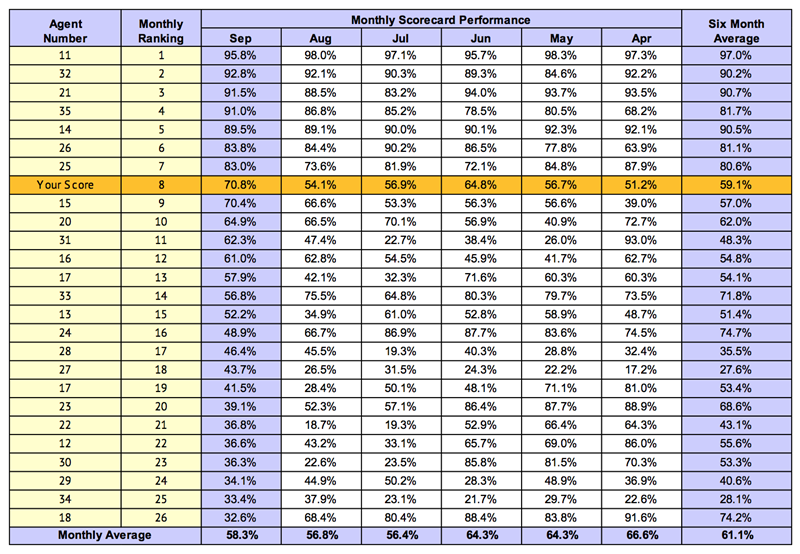
Finally, there is the intangible factor of management effectiveness, which
cannot be overstated. I have seen contact centers transform, almost
overnight, from poor performers to top quartile performers simply by
replacing the manager of the center. These high-performance managers tend
to exhibit several common behaviors. These include, but are not limited
to:
-
Accessibility – an agent can reach the manager whenever they need to
for open and honest communication
-
Team Huddles – the manager values and encourages frequent team huddles
-
Strong Mission – the manager communicates the importance of the
enterprise’s mission
-
Socializing – effective managers make time for socializing both at work
and outside of work
The Elephant in the Room
So far, I have said nothing about compensation as a driver of agent job
satisfaction. But compensation does matter…a lot! The reason compensation
is a taboo subject in the industry is because most managers have little if
any control over what agents are paid. This is unfortunate for two reasons.
First, even minor increases in compensation can have a very positive impact
on agent satisfaction, morale, and performance. Secondly, and more
importantly, increases in compensation have a significant impact on the
economics of a contact center. There is a phenomenon known as the wage rate
paradox whereby increases in agent compensation, up until a certain point,
actually produce an economic benefit for a contact center that is far more than the cost of higher salaries. The best way to illustrate this is
by example.
Imagine staffing a contact center with the lowest cost resources you can
find. On the one hand, you may have minimized your payroll. But on the other
hand you have likely staffed your contact center with relatively
inexperienced agents. No amount of training is going to turn those agents
into high performers. The sacrifices in quality, service levels, customer
loyalty, and revenue that result from hiring the lowest cost agents you can
find are far greater than any amount saved in payroll. By contrast, it has
been shown that offering 20% higher compensation than the market minimum
will attract significantly more qualified agents, thereby producing better
results – higher first contact resolution rates, higher customer
satisfaction, greater customer loyalty, higher revenue production, and yes,
higher job satisfaction.
Benchmarking Ranges for Agent Job Satisfaction
MetricNet’s benchmarking database shows that the average agent job
satisfaction for contact centers worldwide is about 77%. That is, 77% of
contact center agents are either satisfied or very satisfied with their
jobs. This number varies from a low of 44% to a high of 97%.
As mentioned above, agent job satisfaction is usually measured through
annual or semi-annual satisfaction surveys. These surveys typically contain
five or fewer questions and can be automated using simple online tools
such as Survey Monkey. MetricNet recommends a five-point scale, where a
score of 5 represents Very Satisfied, and a score of 1 represents Very
Dissatisfied. Given the impact of training, coaching, and career pathing on
agent job satisfaction, the survey should include a question about each of
those. For example, “How would you rank the quality of training you receive
in your contact center?” The final, and most important question of the
survey should always be some variation of “How would you rate your overall
job satisfaction in the contact center?”
Maximizing Agent Engagement and Job Satisfaction
As a 30 year veteran of this industry, I have seen contact centers struggle
more often than not with poor morale and low job satisfaction. The good
news is that both of these factors are controllable. Moreover, there is
strong evidence that agent job satisfaction and engagement are highly
correlated. By managing agent job satisfaction, you are simultaneously
driving higher levels of agent engagement. Some of the primary levers you
have for driving job satisfaction, and hence agent engagement, include
training, coaching, and career pathing. Additionally, psychometric testing
and agent scorecards are two underutilized tools that can have a
significant positive impact on agent engagement in the workplace. Finally,
compensation levels that are well above the market minimum not only produce
higher levels of job satisfaction, but they also create economic benefits for the
contact center that far outweigh the cost of higher salaries.